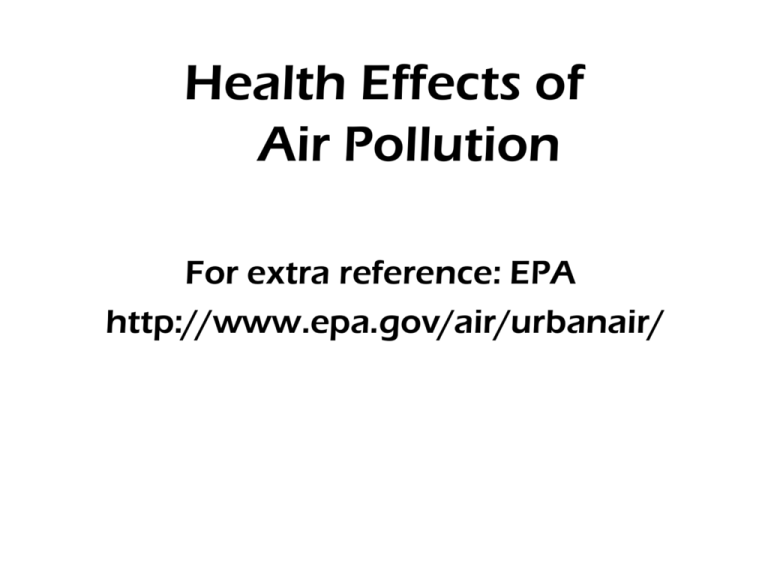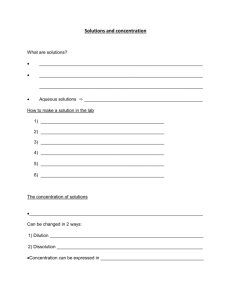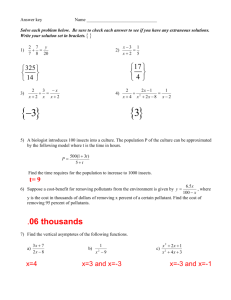Health Effects of Air Pollution
advertisement

Health Effects of Air Pollution For extra reference: EPA http://www.epa.gov/air/urbanair/ Criteria Air Pollutants • Gases: O3, CO, NOx, Sox • Particles: PM2.5, Pb – NAAQS from US Federal Clean Air Act •Primary standards: protect public health, including “sensitive” populations •Secondary standards: protect public welfare Hazardous Air Pollutants: Hg, dioxins, etc – Regulated under 1990 CAA Amendments • Some other important health aspects – Bioaerosols, medicinal purposes Exposure to Air Pollutants • Chronic • Acute – Air Pollution Episode – short-term increase concentrations • Dependent on local conditions • Epidemiological studies – Statistical relationship between environmental factors and human disease – Population susceptibility or change – Latency period • Lung cancer – up to 30 years • Toxicological studies – Determine effects of toxic substances • Pollutant interactions Smog Episode in New York City, 1963 National Archives, photo by Chester Higgins Respiratory System • Pollutants transported in via inhalation-respiratory tracts • Person at rest breathes 12 to 15 times a minute (10 liters/min) • 3 parts of respiratory system – Naso-pharyngeal (HAR) – Tracheo-bronchial (TBR) – Pulmonary-Alveolar (GER) • Lungs serve as portal of entry – Highly permeable and lots of blood flow – Pulmonary-Alveolar Surface Area > 75 m2 Nasal Cavity Nose Throat (pharynx) Mouth Bronchus Bronchiole Alveolus Diaphragm Windpipe (Trachea) Left lungs Ribs Capillary Wall of the air sac Carbon Dioxide is transferred to air Oxygen is absorbed into blood Red Blood Cell Small aerosol particles can penetrate through the alveoli wall Respiratory System • Natural protection mechanisms (for particles) • Naso-pharyngeal (HAR) – Nose hairs (filter particles) – Cough, Sneeze – Mouth breathing vs nasal breathing • Tracheo-bronchial (TBR) – Mucociliary “escalator” – Bronchial constriction • Pulmonary-Alveolar (GER) – Macrophages (phagocytosis) – No cilia in Alveoli Question: Do the natural protection mechanisms protect against toxic gases such as CO, O3, SO2 ? Respiratory Particle Cleaning Mechanisms Clearance Mechanism Site Cleaned Rate of Cleaning Cough Trachea, brochus Instantaneous Ciliary Large Bronchi bronchiole tree Bronchiole airways macrophages Alveoli (air sacs) 0.5 hr 3 hrs 6 hrs 24 hrs lymphatics Months,years Lung tissue Criteria Air Pollutants: Particulate Matter PM • Small solid/liquid aerosol particles that remain suspended in air • Causes: materials handling, combustion processes, gas conversion reactions • Main sources: industrial processes, coal and oil burning, diesel motor vehicles Pollutant Primary Stds. (human health) Averaging Times Secondary Stds. Particulate Matter (PM10) Replaced with PM 2.5 Annual (Arith. Mean) 3 150 µg/m Particulate Matter (PM2.5) 15.0 µg/m 35 µg/m 3 3 24-hour Annual (Arith. Mean) 24-hour Same as Primary Criteria Air Pollutants: Particulate Matter • Following inhalation: two possible fates – Deposition or Exhalation • Particle Fate depends upon: – Aerodynamic & physiological behavior (human being) • Methods of Particle Deposition – Interception, Inertial Impaction, Brownian Diffusion, Electrostatic Attraction, Gravitational Settling Criteria Air Pollutants: Particulate Matter • Deposition Mechanisms – Inertial Impaction • Predominant for dp 3 m PM2.5 regulations • Primarily in Nasopharyngeal or Tracheobronchial regions – Brownian diffusion • Predominant for dp 0.5 m • Primarily in PulmonaryAlveolar region – Gravitational Settling • 3-5 m (VTS dar2) • Distal regions of bronchial airways • Minimal Mechanisms – Electrostatic Attraction – Interception • Elongated particles such as fibers Particulate Matter DF=Total DFHA=Head Airways DFTB=Tracheobronchial DFAL=Alveolar region Brownian Diffusion Inertial Impaction dp<0.1 m 0.1<dp<1 dp>PM2.5 • Why is there a dip in particle deposition between 0.1 and 1 m? • Assume this is for nasal breathing. • How might this graph change for mouth breathing? Criteria Air Pollutants: Particulate Matter • Wheezing & coughing to heart attacks and death • TSP (Total Suspended Particles) – In presence of SO2, direct correlation between TSP and hospital visits for bronchitis, asthma, emphysema, pneumonia, and cardiac disease – Studies suggest ~60,000 deaths from PM – 1% increase in mortality for10 g/m3 increase in PM •Respiratory mortality up 3.4% for the same Cardiovascular mortality up 1.4% for the same Criteria Air Pollutants: Particulate Matter • PM10 dp <10 m, coarse (2.5-10 m) & fine particles – Particles > 10 m mostly deposited in nasal-pharangycal • PM2.5 (<2.5 m, fine particles) – Serious health effects in alveolar/gas exchange region shift in EPA regulation changed PM10 to PM2.5 Toxic or Carcinogenic – pesticides, lead, arsenic, radioactive material 8% Increase in lung cancer for each 10 g/m3 increase in PM2.5 Criteria Air Pollutant: Particulate Matter • Asthma – 14 Americans die/day of asthma (3 times greater than 20 yrs ago) – More medicine, more doctor & hospital visits more health care costs • Particulate episodes in presence of SO2 (“Killer Smogs”) – 1930: Meuse Valley in Belgium – 60 deaths – 1948: Donora, Pennsylvania - 20 deaths – 1952: “Lethal London Smog”- 12,000 deaths Criteria Air Pollutants: Carbon Monoxide CO • Colorless, odorless, tasteless gas “Silent Killer” – Cause: incomplete combustion of carbon based fuels – Source: transportation sector, residential heating units – NAAQS regulates CO in outdoor air • OSHA (50 ppm CO averaged over 8-hour period) Pollutant Primary Stds. Averaging Times Secondary Stds. Carbon Monoxide 9 ppm 8-hour None 1-hour None 3 (10 milligram/m ) 35 ppm 3 (40 milligrams/m ) Criteria Air Pollutants: Carbon Monoxide CO • Reacts with blood hemoglobin – Forms carboxyhemoglobin (HbCO) rather than oxyhemoglobin (HbO2) – Prevents oxygen transfer • Toxic effects on humans – Low-level: cardiovascular & neurobehavior – Headaches/nausea/fatigue/ death – Oxygen deficient to vulnerable people (anemia, chronic heart or lung disease, high altitude residents, smokers) • Cigarette smoke: 400-450 ppm; smoker’s blood 5-10% HbCO vs 2% for non-smoker Criteria Air Pollutants: Carbon Monoxide CO • Concern in homes - Install CO monitor • No indoor CO regulations • >70 ppm flu-like symptoms (w/out fever) • 150-200 ppm disorientation, drowsiness, vomiting • >300 ppm unconsciousness, brain damage, death – 500 Americans die/year from unintentional CO poisoning • Treatment: fresh air, oxygen therapy, hyperbaric chamber Criteria Air Pollutants: Ozone O3 • Cause: atmospheric photochemical reaction • Reactants: Hydrocarbons & Nitrogen Oxides • NAAQS .08 ppm or 80 ppb 8 hr average .12 ppm or 120 ppb 1 hr average • Acute Health effects – Severe ear/nose/throat irritation – Eye irritation at 100 ppb ozone – Interferes with lung functions • Coughing at 2 ppm ozone • Chronic Health Effects – Irreversible, accelerated lung damage – Why do we use ozone as disinfectant for water and wastewater treatment? Criteria Air Pollutants: Nitrogen Oxides NOx • Cause: Fuel combustion at high temps • Source: mobile & stationary combustion sources • Prolonged exposure pulmonary fibrosis, emphysema, and higher lower respiratory tract illness in children • NAAQS = Annual Average 0.053 ppm as NO2 • Toxic effects at 10-30 ppm NOx – Nose and eye irritation – Lung tissue damage • Pulmonary edema (swelling) • Bronchitis • Defense mechanisms – Pneumonia – Aggravate existing heart disease Criteria Air Pollutants: Sulfur Oxides SOx • • • • • • Cause: Burning fuel that contains sulfur Source: Electric power generation, diesel trucks Gas and particulate phase Soluble and absorbed by respiratory system NAAQS = 0.14 ppm 24 hr average Short-term intermittent exposures – Broncho-constriction (temporary breathing difficulty) – Ear/Nose/Throat irritation – Mucus secretion • Long-term exposures – Respiratory illness – Aggravates existing heart disease • Intensified in presence of Particulate Matter – London “Killer” Smog health effects were combination of the two air pollutants (SOx and aerosol particles) Criteria Air Pollutants: Lead (Pb) • Source: burning fuels that contain lead (phased out), metal processing, waste incinerators, lead smelters, lead paint • Absorbed into blood; similar to calcium • NAAQS = 1.5 g/m3 Pb Quarterly Average • Kellog Idaho Lead smelter emissions caused children in region to have lower IQ and brain effects (UW CEE grad was EPA engineer in charge of cleanup at this site). • Accumulates in blood, bones, muscles, fat – Damages organs – kidneys, liver, brain, reproductive system, bones (osteoporosis) – Brain and nervous system – seizures, mental retardation, behavioral disorders, memory problems, mood changes, • Young children - lower IQ, learning disabilities – Heart and blood – high blood pressure and increased heart disease – Chronic poisoning possible Criteria Air Pollutants: Air Quality Index (AQI) • EPA AQI is for reporting daily air quality. The AQI focuses on short term health effects (1-48 hr after exposure). AQI is calculated from concentrations of SO2, CO, O3, and particles. • AQI values in the 0-50 indicates Good air quality. • AQI in the 51-100 range indicates Moderate air quality and exposures will cause short term health effects to some sensitive people (and unhealthy effects for long-term exposure for most people). • Pilat opinion is that “Moderate” air quality is not very healthy. The SO2, PM, and O3 NAAQS standards are set at levels with proven damaging health effects with little or no margin of safety; the CO NAAQS standard has a margin of safety. Criteria Air Pollutants: Air Quality Index (AQI) • AQI is the highest magnitude of the PM, SO2, CO, and O3 individual Index values AQI Value Air Quality 24 hr PM2.5 (g/m3 ) 24 hr SO2 (ppm ) 8 hr CO (ppm) 8 hr O3 (ppm) 0-50 Good 0-15.4 0.0 - .034 0.0-4.4 .000-.064 51-100 Moderate 15.5-40.4 .035-.144 4.5-9.4 .065-.084 101-150 Unhealthy to Sensitive 40.5-65.4 .145-.224 9.5-12.4 .085-.104 151-200 Unhealthy 65.5-150.4 .225-.304 12.5-15.4 .105-.124 201-300 Very Unhealthy 150.5-250.4 .305-.604 15.5-30.4 .125-.374 35 µg/m3 0.14 ppm 9 ppm .08 ppm NAAQS http://airnow.gov.index.cfm?action=aqiconc_aqi_calc • Equation for Calculating an Air Pollutant AQI Index Value I Hi I Lo Cp BPLo I Lo I P BPHi BPLo Ip Index magnitude for air pollutant P Cp concentrat ion for pollutant P I Hi AQI value correspond ing to BPHi I Lo AQI value correspond ing to BPLo BPHi breakpoint that is greater than Cp BPLo breakpoint that is less than Cp Calculate the AQ Index of air that contains 0.077 O3 (8 hr average), 8.4 ppm CO (8-hr average), & 54.4 g/m3 PM 2.5 Particles (24-hour average) 100 51 .077 .065 ppm 51 82 I ozone 0.084 .065 ppm 100 51 8.4 4.5 ppm 51 90 I CO 9.4 4.5 ppm 150 101 IPM2.5 54.4 40.5 101 128 65.4 40.5 The index calculated for the air pollutant PM2.5 is the highest magnitude so the Air Quality Index = 128 http://www.k12science.org/curriculum/airproj/whataqi.html Hazardous Air Pollutant HAP: Mercury Hg • Elemental Hg inhaled as a vapor, absorbed by lungs • Cause: vaporized mercury • Sources: coal combustion, accidental spill, mining (teeth silver fillings) • Effects: Nervous system (acute, high), respiratory system (chronic, low), kidneys, skin, eyes, immune system; Mutagenic properties • Symptoms – Acute: chills, nausea, chest pains/tightness, cough, gingivitis, general malaise – Chronic: weakness, fatigue, weight loss, tremor, behavioral changes istockphoto.com http://www.istockphoto.com/imageindex/728/1/728179/Mercury_drops_Hg.html Hazardous Air Pollutant Dioxins • Generic term for several chemicals that are highly persistent in the environment – chlorinated dibenzo-p-dioxins (CDDs) – chlorinated dibenzofurans (CDFs) 2,3,7,8-Tetrachlorodibenzo-p-dioxin – certain polychlorinated biphenyls (PCBs) • Cause: burning hydrocarbons in presence of chlorine or chlorides • Sources: waste incinerators • Notice the Chlorine atoms on the benzene ring type molecules (probably all these type 2,3,7,8-Tetrachlorodibenzofuran compounds are carcinogenic) • Does using Chlorine to treat drinking water result in the formation of carcinogenic compounds? 3,3',4,4',5,5'-Hexachlorobiphenyl Hazardous Air Pollutant: Dioxins • Varying toxicity – Problems with high exposures – Exact effects of low exposures not known • Health Effects – Carcinogenic Comparative Photos Showing Ukraine’s Viktor Yushchenko Immediately Prior To And Immediately Following Dioxin Poisoning http://en.wikipedia.org/wiki/Viktor_Yushchenko (Note: this is an extreme case of dioxin poisoning) • Some are “known human carcinogen” (2,3,7,8 tetrachlordibenzo-p-dioxin, TCDD) • Other dioxins are “reasonably anticipated to be a Human Carcinogen” – Reproductive and developmental effects – Chloracne Other Aerosols: Bioaerosols • Aerosols with organic origin – Non-viable: pollen, dander, insect excreta, sea salt – Viable: microorganisms • Cause: aerosolization of organic materials • Sources: – Human: sneezing, coughing – wind, waves, Waste water treatment plants,cooling towers • Health Effects: allergies (pollen) to death (pathogenic organisms) Mechanical aeration at Waste water treatment plant – Pathogenic – Minimum Infectious Dose Other Aerosols: Bioaerosols • Allergies – Pollen, dander, fungi (spores) • Airborne transmission of disease – Bird flu, SARS, Legionnella (pneumonia) – Indoor Air Quality • Ventilation Systems – moist ductwork, protection, recycled air • Office Buildings – Sick Building Syndrome – Hospital (nosocomial) • Biological Warfare – Anthrax, Ebola virus Morning Glory Pollen SEM University of West GA Microscopy Center http://www.westga.edu/~geosci/wgmc/plants_pics.htm Other Aerosols: Medicinal Applications • Purposely applied medicine • Take advantage of lung’s large surface area of the thin membrane of alveolar air sacs through which aerosol particles (especially liquid solutions) easily pass into the blood. • Asthma – Inhaler • Diabetes – Pfizer uses Insulin



